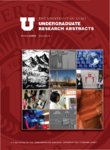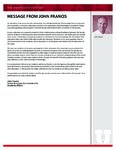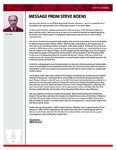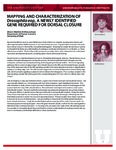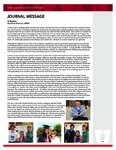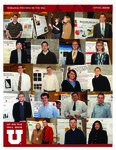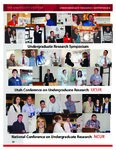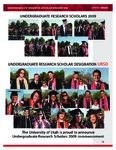Contents | 9 of 17
Research Posters on the Hill of undergraduate research abstracts vol 9
| Title | University of Utah Undergraduate Research Abstracts, Volume 9, Spring 2009 |
| OCR Text | Show A Message from President Young.....2 A Message from John Francis.....3 A Message from Steve Roens.....4 Undergraduate Abstracts.....5 A Message from Jill Baeder.....69 Research Posters on the Hill.....70 Charles H. Monson Prize Winner.....99 Undergraduate Research Conferences.....104 Undergraduate Research Scholars.....105 Psychology Senior Thesis Program.....106 Honors Program.....114 Alphabetical Index.....187 |
| Subject | University of Utah -- Students -- Periodicals |
| Publisher | J. Willard Marriott Library, University of Utah |
| Date | 2009 |
| Type | Text |
| Format | application/pdf |
| Language | eng |
| Rights Management | Digital image © copyright 2009, University of Utah. All rights reserved. |
| Holding Institution | Office of Undergraduate Studies Sill Center 195 S. Central Campus Dr. Salt Lake City, UT 84112 Office of Undergraduate Studies Sill Center 195 S. Central Campus Dr. Salt Lake City, UT 84112 |
| Source Material | Bound journal |
| Source Physical Dimensions | 14 cm x 21 cm |
| ARK | ark:/87278/s6j966gm |
| Temporal Coverage | Spring 2009 |
| Setname | uu_urop |
| ID | 417424 |
| Reference URL | https://collections.lib.utah.edu/ark:/87278/s6j966gm |
Page Metadata
| Title | Research Posters on the Hill of undergraduate research abstracts vol 9 |
| OCR Text | Show RESEARCH POSTERS ON THE HILL SPRING 2009 UP ON THE HILL 2009 THE UNIVERSITY OF UTAH RESEARCH POSTERS ON THE HILL 2009 UP ON THE HILL 2009 RESEARCH POSTERS ON THE HILL SPRING 2009 UP ON THE HILL 2009 73 ETHICAL ISSUES SURROUNDING GENETIC INTERVENTION As of mid-2008, there are more than 1,200 tests avail-able to determine the genetic component of a variety of disorders and predispositions. The state of Utah cur-rently requires 44 genetic tests be performed on all newborns as an intervention against certain physical disorders and predispositions. The number of genetic tests available will continue to increase in the future, which will require policymakers to make decisions con-cerning what tests will be required, allowed, or prohib-ited. Guidelines for making such decisions require understanding of the causal relationship between genotype and phenotype; however, critical analysis of the causal criteria to justify these decisions is currently lacking. We will attempt to ascertain what causal criteria is currently used to justify neonatal genetic testing and what is sufficient or insufficient with such criteria related to the expression of phenotypic traits. Further, we will explore the relationship between varying levels of causal knowledge and justification for seeking genetic intervention. Based on this new understanding of the causal criteria as a basis for policymaking, we will attempt to derive ethical guidelines to bridge the gap between causal knowledge and the permissibility of neonatal genetic intervention. Our goal is to provide policymakers with usable guidelines to make informed, ethical decisions for requiring, allowing, or prohibiting genetic tests ranging from physical disorders such as PKU to complex behavioral traits such as Antisocial Personality Disorder THE UNIVERSITY OF UTAH RESEARCH POSTERS ON THE HILL 2009 Roger Aboud (James Tabery) Department of Philosophy University of Utah 74 BEYOND COMPEN-SATION: INADE-QUACIES OF THE RADIATION EXPOSURE COMPENSATION ACT (RECA) Tori Ballif (Bob Goldberg & John Francis) History/Honors University of Utah This project examines the political and social his-tory of the Radiation Exposure Compensation Act (RECA) - the current legislation available for vic-tims of radiation exposure from nuclear testing in the Nevada desert. During the Cold War, the Nevada Proving Site saw four decades of atomic testing in which the federal government conducted over 900 atmospheric and underground nuclear tests. This testing exposed American citizens to dan-gerous levels of radioactive fallout, which resulted in high rates of cancer, birth defects, sterility, and other radiation-induced illnesses. Following the Downwinders' unsuccessful lawsuit against the government, Congress engaged in a peri-od of prolonged debate regarding the creation of compensation legislation for nuclear victims. The gov-ernment was hesitant to admit fault and shoulder the enormous financial burden, and the scope of the proposed legislation continued to diminish with each successive bill. In 1990, Senator Orrin Hatch (R-Ut) achieved passage of his Radiation Exposure Compensation Act (RECA). Though this legislation was seen as a political victory for Hatch, it left exposed populations with little to celebrate. RECA allotted com-pensation to individuals living or working "downwind" of the test site, atomic test site workers, and ura-nium miners. Claimants had to shoulder a heavy burden of proof and were limited by arbitrary geo-graphical and medical qualifications. This project researches the history of the Radiation Exposure Compensation Act, examining the context, creation, and current place of RECA, paying particular attention to the role that local and national poli-tics play in the issue of nuclear testing. Using the grassroots mobilization of the Downwinders as con-text for this legislation and the ensuing controversy, it also examines key players whose involvement and influence helped to guide this issue. On a broader level, this research looks at the way that the compensation legislation controversy developed - both temporally and regionally - as a means of examining larger economic and cultural changes in the American West. 1A term used to describe fallout victims who were ‘down wind' of the radiation. RESEARCH POSTERS ON THE HILL SPRING 2009 75 VENTURE CAPITAL STRATEGY FORMULATION Venture capitalists invested $29.4 billion in 3,813 deals in 2007. The desired return of a venture capital invest-ment is a return of five to ten times investment, within three to five years. On average, only one in ten ven-ture- funded companies delivers the desired return to investors. If the heretofore rate of success remains con-sistent, $26.6 billion invested in 2007 will fail to achieve desired returns for investors. In order to understand the causes of the low success rate in the venture capital industry, I conducted research of the investment decision-making systems of five venture capital funds. The decision of the venture capitalist to invest or not invest in a growth enterprise is an implicit prediction of the eventual output of the target enterprise. In each of the funds I researched, the venture capitalist uses a prediction mecha-nism called an investment memorandum to formulate the investment decision. The investment memo-randum is a tangible consequence of due diligence-the research conducted to predict the value of an investment. My research yielded three logical flaws in the investment memorandum as a prediction mechanism for venture capital investment decisions. The first flaw is that the mechanism allocates equal value to condi-tions of disparate value, thereby misrepresenting the cumulative value of a potential investment. The second flaw is that the mechanism applies fallacious meaning to prima facie noncontributory condi-tions. The third flaw is that the mechanism is structured as a prospectus, inherently overestimating mer-its and underestimating risks. My hypothesis is that the three logical flaws I uncovered in the investment memorandum jointly consti-tute the primary cause of the low success rate of venture-funded growth companies. My proposition is that fundamental adaptations in the investment memorandum, in response to the flaws I uncovered, will significantly increase the rate of success in the venture capital THE UNIVERSITY OF UTAH RESEARCH POSTERS ON THE HILL 2009 Bradley Call Barth (Matthew Haber) Department of Philosophy University of Utah 76 COMPUTER AIDED GEOMETRIC MODEL OF POLYHEDRAL TRANSFORMA-TIONS Stephen Bayles (Robert McDermott) Department of Computer Science - CHPC University of Utah A computer aided geometric model for a polyhe-dral transformation was written in C++, OpenGL and GLUT. This geometric model allows a user to interactively change the shape of a closed convex polyhedron derived from 10 face planes in a fun-damental region. Given different inputs, a differ-ent shaped polyhedron was output. For some inputs, the output was a Platonic or Archimedean polyhedron. For other inputs a more complex polyhedron was output. This transformation is based on a fundamental region that is formed by 3 sym-metry planes intersecting at the centroid of a polyhedron. This fundamental region is combined with 3 different sets of transformations to produce a polyhedron for either a tetrahedral, an octahedral, or an icosahedral family of polyhedra. Using the interactive software, a polyhedron transforms smoothly and continuously from a regular polyhedron, to a truncate polyhedron, to a dual polyhedron, to a stellate polyhedron along with many transitional polyhedra. RESEARCH POSTERS ON THE HILL SPRING 2009 77 A STRUCTURE ACTIVI-TY RELATIONSHIP STUDY OF C-6, A NOVEL COMPOUND WITH SELECTIVE ACTIVITY AGAINST BREAST CANCER TUMOR CELLS Researchers have focused on improving cross-coupling reactions because of their importance in the synthesis of pharmaceuticals1 and natural products.2 The Sig-man group developed a unique method for Pd-cat-alyzed cross-coupling reactions, a reductive cross-cou-plings reaction, that has increased the number of possible products that can be obtained. (Scheme 1).3 Sigman group member Keith Gligorich, using this novel reductive cross-coupling reaction, synthesized the product C-6 (1). In initial screens performed by the Huntsman Cancer Institute (HCI) on several different compounds, C-6 preferentially killed tumor cells (Figure 1). In further stud-ies, C-6 selectively destroyed tumor cells over wild-type cells both in human and mice basal cell lines as well as mouse ER+, ER- and HER2+ breast cancer cell lines. C-6's activity in these different cell lines is significant as current treatments usually are only effective against one cell line. Thus, further research could prove C-6 to be a new candidate for treating a wider range of breast cancers. The above results, along with another characteristic of C-6 seen in in vitro studies, support the hypothe-sis that C-6 targets a specific protein in tumor cell pathways. According to results from a 3D matrigel drug screening assay developed by Dr. Bryan Welm of the Huntsman Cancer Institute (Table 1), the (d)-enan-tiomer of C-6 shows greater activity than the ( )-enantiomer. The greater effectiveness of one enantiomer over another suggests that C-6's ability to selectively kill tumor cells is due to its structure. These results led to research efforts in structure activity relationship studies to identify C-6's pharma-cophore structure, synthesize active analogs for target identification and in vivo studies and to improve C-6's pharmacological properties. Future research will include synthesizing more derivatives to gain addi-tional information on C6's unique mechanism of action. THE UNIVERSITY OF UTAH RESEARCH POSTERS ON THE HILL 2009 Carol Bills (Matthew S. Sigman) Department of Chemistry University of Utah LnPdIIX2 LnPdII H X LnPdI I X L R1 n PdI I R2 R1 LnPd0 LnPdII X R H H + HX OH O Alcohol Oxi dation A B D C E H R2SnBu 3 XSnBu 3 R1 O 2 + 2 HX H2O2 R1 R2 H Transmetallation Reductive Elimi nati on R1 C' Alk ene Inser tion SnBu 3 OH + O HX + Scheme 1. Reductive Cro ss-Cou pl ing Reaction - Proposed Mechanism. C-6 N H O O 1 C-6 N H O O 1 C- 6 N H O R O 2: R= Me 3: R= Ethyl 4: R= iPr 5: R= Benzyl 6: R= Ph C- 6 N H S O *7 C-6 N H N H O 8 C-6 N H O 9 *1 0 C-6 H3N 11 Cl N H O O R *12: R=H *13: R=CH3 *1 4: R=Ethyl *15: R=HC=CH 2 *16: R=t Bu C-6 N H S O O Table 1. Drug Screen Cell Assay References 1. King, A.O.; Yasuda, N. Top. Organomet. Chem. 2004, 6, 205. 2. Nicolaou, K.C.; Bulger, P.G.; Sarlah, D. Angew. Chem., Int. Ed. 2005, 44, 4442. 3. Gligorich, K.M; Cummings, S.A.; Sigman, M.S.; J .Am. Chem. Soc. 2007, 129, 14193. 78 THE ROLE OF THE DORSAL HIPPOCAMPUS IN OBJECT RECOGNITION Thomas Blakemore (Raymond P. Kesner) Department of Psychology University of Utah Recognition of a previously experienced object is split into two processes supported by separate neurological structures: feature familiarity (sup-ported by the lateral entorhinal cortex) and con-text recollection (supported by the medial entorhinal cortex). A third, distinct structure is believed to then integrate information from the lateral and medial sections of the entorhinal cor-tex in encoding and retrieval in regards to object recognition. My study, based on previous studies, hypothesizes the dorsal section of the hippocampus as the integrating structure. To test this hypothesis I have created lesions to the dorsal hippocampus of six rodents using ibotenic acid (this acid opens NMDA channels to calcium which floods and destroys the brain cells) and performed one sham surgery as a control. After a recovery period (one week), I run the rodents through two tasks designed to separately test their capability in regards to feature familiari-ty, context recollection, and integration of the two. The first task gives the animal three five minute tri-als in which to explore two objects followed by a fourth trial in which either one object is replaced (item), one object is moved (context), or one object is removed and the new object is placed in a new location (item and context). The second task requires the animal to knock over objects in order to retrieve food rewards. To perform each trial, the animal must learn a rule based on either item type, item location, or item type and location simultaneously. The animals are run through trials of all three types to test their ability to learn each rule. RESEARCH POSTERS ON THE HILL SPRING 2009 79 SOOT OXIDATION IN PREMIXED FLAMES Soot has significant impact on human health and radiative forcing. This study focuses on soot oxidation and fragmentation as a function of fuel properties and temperature. A two-stage premixed burner for soot formation and oxidation is used. Rates of soot oxida-tion are evaluated based on measurement of particle size distribution (PSD) in the first and second stage burners. In this study, a fuel rich ethylene-air flame is used to form soot which is then oxidized under differ-ent lean conditions (F = 0.7 - 0.9). PSDs are determined using a Scanning Mobility Particle Sizer as well as an aerosol spectrometer allowing counts of soot particles ranging from 3 nm to over 300 nm. Mass calculated from the PSD's is compared to mass collected by using filters. These measurements allow us to obtain rate information during oxidation. Presently the results for PSD, mass and number concentration are indicative that soot fragmentation is occurring in the second burner. This information will be used to estimate the soot oxidation rates and elucidation of the role of OH, O and O2. Improved rates will allow for prediction of engine emissions. Future work will include similar studies using surrogates and mixtures of liquid fuels. THE UNIVERSITY OF UTAH RESEARCH POSTERS ON THE HILL 2009 Benjamin Brewster, Carlos Andres Echavarria, Vincenzo Romano (Adel F. Sarofim, JoAnn S. Lighty) Department of Chemical Engineering University of Utah 80 THE ROLE OF CA3 RECURRENT COL-LATERALS IN CUE-INDUCED PATTERN COMPLETION LEADING TO RELAPSE INTO DRUG TAKING AND DRUG SEEKING BEHAVIOR Jascha Kennedy Clark (Raymond P. Kesner) Department of Psychology University of Utah In the context of drug addiction, relapse is defined as the return to drug seeking and drug taking behavior after a prolonged period of abstinence. Relapse is a serious problem that still requires exten-sive research in order to generate sufficient knowledge of the mechanisms that mediate it. Often, the role of craving is cited as a primary motivating factor for relapse. One possible mechanism that could support this observation is known as pattern completion, a process wherein presentation of an incom-plete stimulus complex reinstates the complete, previously learned pattern. It has been proposed that during retrieval of information, the CA3 recurrent collaterals of the hippocampus play a major role in retrieving complete previously learned patterns in the face of an incomplete stimulus complex input to the hippocampus (pattern completion). Support for the operation of a pattern completion process is based on a spatial pattern completion task allowing one to examine the effects of lesions of the CA3 sub-region of the hippocampus or control lesions, on pattern completion in the presence of varying numbers of available cues during the choice or retrieval phases of the task. Methods: We use a variant of the conditioned place preference task in which the number of available cues is parametrically adjust-ed to assess the role of pattern completion in cue-induced reinstatement of drug-seeking behavior and to determine whether disruption of pattern completion secondary to infusion of naloxone into the CA3 region disrupts cue-induced reinstatement. Preliminary results indicate that naloxone will disrupt the reinstatement (preference for cocaine conditioned cues) for four cues, but not for a single cue, suggest-ing a significant impact on pattern completion within the CA3 region. RESEARCH POSTERS ON THE HILL SPRING 2009 81 METABOLIC BIO-MARKERS OF EARLY RETINAL OXIDATIVE STRESS Purpose: As part of our program to discover the initia-tors of retinal remodeling, we are defining the charac-teristic stress signatures of photoreceptors and Müller glia. Our hypothesis is that acute or prolonged oxida-tive stress compromise the function of Müller glia to maintain homeostasis and to provide neuroprotec-tion. Methods: We explored the earliest phases of acute oxidative stress in a model of retinal phototoxicity in Balb/c albino mice. Retinas were harvested during light exposure (0h-24h) and after light exposure (0d-4d), and processed for conventional metabolic and proteomic profiling. Cell death rates were assessed with Terminal deoxynucleotidyl transferase dUTP nick end labeling (TUNEL) and 8-hydroxydeoxyguanosine (8-OHdG) assays.Results:TUNEL and 8-OHdG labeling of photoreceptor nuclei started at 6 hours after the onset of light exposure. In areas of cell death we observed enhanced levels of rod aspartate and enhanced levels of Müller glial arginine. Müller glia also displayed rapid and robust changes in signal transduction, glutamate metabolism, osmoregulation, redox regulation, and retinoid binding proper-ties. Conclusions: Enhanced rod aspartate and Müller arginine are novel markers of early retinal stress. The response of Müller glia to acute stress is rapid and robust. We are investigating the effect of early Müller glial reprogramming on neuroprotection and neural remodeling. THE UNIVERSITY OF UTAH RESEARCH POSTERS ON THE HILL 2009 William D Ferrell, Felix Vazquez-Chona, Yanhua Lin, Bryan Jones (Robert E Marc) Department of Opthalmology, Moran Eye Cntr University of Utah School of Medicine 82 CHARACTERIZA-TION OF THE STRUCTURE AND COMPOSITION OF THE RAT SCIATIC NERVE Kylee Fotheringham, M. Ben Christensen (Patrick A. Tresco) Department of Bioengineering University of Utah In order to assess the effectiveness of nerve regenerative technologies or the biocompatibility of implanted electrodes in the peripheral nervous system, histopathological studies of regenerating or implanted nervous tissue need to be conduct-ed post implantation. These studies should be aimed at determining the affects on the nerve by measuring morphometric parameters such as fascicle areas, fiber counts, fiber areas, and fiber diameter and g-ratio (ratio of axon diameter to total fiber diam-eter) distributions. In the past, many studies have used rat animal models with the contralateral (non-implanted) nerve serving as a control. However, literature on the viability of using the contralateral nerve as a control for sciatic nerve experiments, as well as normal rat sciatic nerve structure and compo-sition, is incomplete. We therefore examined the nerve composition and organization in normal, unim-planted rats and use that data do determine the viability of using the contralateral nerve as an internal control. To this end, five male Fisher 344 rats (225-250g) were sacrificed via transcardial perfusion with PBS. The left and right sciatic nerves were dissected free, post-fixed in 4% paraformaldehyde/2% glu-taraldehyde followed by 2% osmium tetroxide, dehydrated in a series of alcohols, and embedded in an epoxy resin. Nerves were thin-sectioned to 0.7Ìm, stained with Thionin and Acridine Orange, and imaged at high magnification (1000x). Images were analyzed using Labview and Adobe Photoshop CS. Morphometric parameters were compared between the left and right sciatic nerve using a standard paired t-test with P-values less than 0.05 considered significant. Results showed no statistical difference between the right and left sciatic nerve of the rats for any parameter measured, suggesting that the contralateral nerve might be able to serve as a control for future experiments. Base line normal values for the structure and composition of a rat sciatic nerve were also established RESEARCH POSTERS ON THE HILL SPRING 2009 83 PROPERTIES OF CaP NANOSHELLS FOR PHOTOEMISSION AND PH TITRATION WITH FLUORESCEIN The goal of this project is to develop new tools for measuring properties such as pH inside cells that are affected by diseases like cancer or which have been exposed to environmental toxins. When intracellular pH changes from its normal value it causes a change in metabolic and even genetic functions. Knowing the cell's overall pH change can be an early warning signal of trouble, and understanding where in the cell it begins to happen can be a target for treatment to avoid more serious conditions. To really understand the mechanisms behind pH change in cells, it would be an advantage to monitor conditions near specific organelles over the course of several days, but typical probe molecules simply do not survive that long. To overcome this problem we would like to develop a very durable pH sensitive nanoparticle that is safe for cells to be in contact with for long periods of time, but do not lose their abilities to detect or to respond to pH. The nanoparticles developed in this work are nanoshells in which the inner core of the particle is hollow and filled with liquid and pH sensitive dyes. A thin outer coating of biocompatible inorganic material, calcium phosphate, provides stability and excludes most unwanted materials, but allows protons to pass through. Four examinations were accomplished. First, we determined the upper limit of encapsulated concentration of the pH sensitive dye molecule fluorescein that yielded the most light emission. The purpose of this was two fold: a) to obtain the best case situation for synthesis and eventual use of the particles, and b) to test the hypothesis that inter-molecular charge repulsions of molecules inside the nanoshells could inhibit collisional energy transfer (e.g. quenching) between molecules under certain conditions. Second, we determined whether there is energy migration between fluorescein-filled nanoshells. Energy transfer (quenching) is considered to be a distance dependent process requiring molecular orbital interactions but energy migration processes may still occur for thin shells. Knowing if this is possible can help define the concentration of nanoparti-cle used in a real application. Third, we compared the pH dependence of fluorescein emission in the particle with that in solution. The purpose of this task was to determine whether the nanoshell encap-sulating environment changed the titratability of fluorescein functional groups. Finally, we determined the relative quantum yield experienced by the nanoshell encapsulated dye relative to that in solution. The intended use for these particles is in microscopy applications with prolonged illumination times, so that minimal photobleaching is required. Ultimately, when the concentration is sufficiently elevated, the molecules are congested and restricted in their movement. Interestingly, CaP coated shells were determined to sustain emission at unusually high internal dye concentrations possibly because the shells prevent the dye molecules from colliding even at a high concentration. The response of pH range-determined pKa shifted from 6.4 to 6.9. This may be caused by interaction between liposomes and fluorescein dyes inside the nanoshells. The change in shape in the titration curves suggests that one or more functional groups in the fluorescein molecules are organized differently in response to pH. The relative quantum yield for emission from flu-orescein in nanoshells was measured as a function of encapsulated fluorescein concentration, and was higher compared with that in solution, and did not photobleach under high light fluxes. THE UNIVERSITY OF UTAH RESEARCH POSTERS ON THE HILL 2009 Kyu Bum Han (Agnes Ostafin) Department of Material Science & Engineering University of Utah 84 SEISMICITY OF THE OAXACA SEGMENT OF THE MIDDLE AMERICAN SUB-DUCTION ZONE Kevin Jensen1, Timothy Carey2, Michael R. Brudzinski2, Enrique Cabral-Cano3, Alejandra Arciniega-Ceballos3, Oscar Diaz-Molina3, D. Charles DeMets4 1Department of Geology and Geophysics University of Utah 2Department of Geology, Miami University of Ohio 3Instituto de Geofísica, U.N.A.M., Ciudad Universitaria, Delegación Coyoacan 4Department of Geology and Geophysics, University of Wisconsin Convergent plate boundaries generate potentially devastating great earthquakes when tectonic stress-es accumulate on the plate interface. The Oaxaca segment of the Middle-America subduction zone offers an ideal opportunity for detailed studies of the plate interface due to its relatively rapid conver-gent rates, unusual shallow subduction angle, and ~50 km trench-to-coast distances that brings the seismogenic and transitional zones of the plate interface ~250 km inland. The short recurrence interval (decades) of megathrust events also allows us to compare current seismicity to past events in detail to examine the asperity and gap hypotheses to better characterize the seismic hazard. A network of seven broadband three-component seismometers was deployed in summer 2006 over an area of ~300 km west-east and 200 km north-south with nominal 80 km station spacing, providing the means to exam-ine seismicity in detail for the first time in this region. We use the Antelope Software package to organ-ize the first nine months of recorded waveforms, perform analyst event detections, generate source locations, and compute local magnitudes. We detected and located over 3000 earthquakes with this method. The bulk of the earthquakes follow the coastline with these hypocenters clustering near the plate interface, but we also detect a number of deeper (>40 km) intraslab earthquakes further inland. The microseismicity we detect outlines the down-dip end of the seismogenic zone near 25 km depth, consistent with the depth and inland extent of previous megathrust events. When the seismicity is compared with other recent studies, we find a clear spatial relationship that suggests a downward pro-gression of deformation with the subductng plate from interplate seismicity to slow-slip events to non-volcanic tremor to intraslab earthquakes. We are also beginning to see temporal relationships between seismicity and episodic tremor and slip, including a swarm of 50 earthquakes at the down-dip end of the seismogenic zone with bursts of activity followed by pulses of non-volcanic tremor activity. RESEARCH POSTERS ON THE HILL SPRING 2009 2008-2009 The Ruth Eleanor Bamberger and John Ernest Bamberger Memorial Foundation Scholar 85 DANCE EDUCATION RESEARCH This study examines the community partnership between Tanner Dance and Granite and Salt Lake City School District. The Side By Side (SBS) Program uses movement specialists who teach students and train teachers as outlined by the Utah State Dance Core Cur-riculum and National Standards in Dance. This study is an interdisciplinary project supported by faculty in the College of Social Work and the Department of Modern Dance at the University of Utah. This research project has been divided into two com-ponents to accomplish a thorough investigative strate-gy; the literature review, and field research from partic-ipants using the SBS Grant. Previous research studies support the use of movement and dance in emotional and intellectual learning for children. However, dance education in schools is an under-researched method of teaching. Given this lack of consistency and reliability in the literature, much attention has gone into the literature review process for this proj-ect to ensure that all current academic resources have been reviewed and are referenced. In collaboration with Dr. Davis, the primary investigator, we compiled a set of questions and topics to guide motivational, qualitative interviews with teachers. These interviews will be recorded and tran-scribed, then reviewed for results regarding the use of dance in education. The study has been designed to recognize strengths and weaknesses of the program, and compare different schools' and individual teachers' styles of implementation. Upon completion of the interviews, anticipated results will demonstrate the extent to which; dance is a useful tool for teachers, a beneficial learning style for students, a vehicle for cognitive and emotional development and an effective tool in building classroom milieu. As this project was supported by seed grant funding, results will be used to apply for additional funding for continuation of research on dance in education. THE UNIVERSITY OF UTAH RESEARCH POSTERS ON THE HILL 2009 Megan Lindsay (Robin Davis) College of Social Work University of Utah 86 VIRTUE AND DEATH: WIDOW SUICIDE AND THE FEMININE CON-SCIOUSNESS IN CHINA AND INDIA Caitlin G. McDonald (Janet Theiss) Department of History/Asian Studies University of Utah This project is an examination of the widow sui-cide and domestic ideals in China and India. Widow suicide in China in the eighteenth-century created a "cult of chastity" around dead women who represented ultimate virtue - that of follow-ing their husband even in death. There is a paral-lel with Indian tradition in the form of sati, the practice of women burning themselves alive on their husbands' funeral pyre. As in China, satis were worshipped as a kind of saint. These suicides were a form of expression and liberation for these women living under patriarchal expectations. Paradoxically, how-ever, the identities of the widows often became lost among the uproar over their deaths. In China, literature and poetry written by women have become the best representations of their posi-tion. In the Ming and Qing dynasties, female writing provided insight into both their lives and deaths. Indian satis differ in this respect. Whereas in China the documentation of widow suicide often occurred among literate women, Indian sati is less well documented because of its occurrence across classes and because women themselves were largely illiterate. Both the defense of and resistance to sati became a discourse between educated men; the issue has only become championed by women in recent years. Both similarities and differences between cults of worship created around suicide imply parallels of soci-etal pressure on Chinese and Indian women. The irony is that the motivation for women to act in this manner objectified them even more as they became symbols for larger debates; feminism, modernity, and traditionalism. The construction of the feminine consciousness is an ongoing issue as historians continue to discover the importance of women's history in the larger picture of globalization. The rem-nants of patriarchal ideals permeate how history was written and how we understand our own gender identities today. Using sources from women themselves and accounts from eyewitnesses, families, and journalists searching for answers has spurred my research to highlight the lives of women whose voices are often missing from contemporary discourse. RESEARCH POSTERS ON THE HILL SPRING 2009 87 MUTATION AND SELECTION OF A HIGHLY VARIABLE MITOCHONDRIAL MINISATELLITE Weakly selected mutations are expected to be an important source of fitness variation in all species because theory says they should be common. Howev-er, they are difficult to study because they do not have obvious phenotypes and they evolve as if they were neutral in small populations where genetic drift is powerful. "Whale lice" are amphipod crustaceans that spend their entire lives on whales. Right whales carry three species of whale lice which are ideal subjects for the study of weakly selected mutations because their environment (right whales) is simple and relative-ly unchanging, their populations are huge, and the northern and southern hemisphere populations have been isolated for millions of years and therefore serve as replicates of the same evolutionary "experiment". Our lab recently discovered an extremely polymorphic minisatellite locus in the mitochondrial genome of the most abundant right whale cyamid (Cyamus ovalis). Individual genomes have anywhere from 3 to 12 tandem repeats of the 11-base-pair repeat unit ATTTTTAAGAA. The distribution of repeat num-bers is nearly identical in northern and southern hemisphere populations, and many individuals have more than one repeat number in their mitochondria. These patterns indicate that mutations to higher and lower repeat numbers occur often and that natural selection on repeat numbers within the observed range is fairly weak. However, the most common number is 3 and to date it is the only num-ber seen in other species. To understand how selection shapes the repeat-number distribution in C. ovalis we are quantifying the repeat numbers of mothers and large numbers of their offspring. If we can determine the rates at which new repeat numbers arise, then we can infer how selection acts to maintain the observed repeat-number distribution in C. ovalis. THE UNIVERSITY OF UTAH RESEARCH POSTERS ON THE HILL 2009 Heather McGirk (Jon Seger) Department of Biology University of Utah 88 SUGAR HOUSE COMMUNITY EARTHQUAKE LOSS ESTIMATION STUDY Stuart Moffatt (Tom Cova) Department of Geography University of Utah State and local governments perform loss estimation studies for local natural hazards in order to inform disaster management efforts. While earthquake loss estimations analyses have been performed for Salt Lake County, the Sugar House Community Earthquake Loss Estimation Study aims to "bring the data clos-er to home" by mapping the total economic loss per single-family residence in the Sugar House Community Council area. A geographic information system (GIS) was used to combine Salt Lake County Assessor data (including building value) with modified parcel bound-aries based on unique addresses. Census data provided average occupancy for residential buildings. Consultation with civil engineering professionals provided a mapping algorithm to derive FEMA build-ing types based on exterior wall types in the assessor database, informed by local construction practices since 1940. The loss estimations are based on a Level 3 HAZUS-MH earthquake analysis with a probabilistic magni-tude 7.0 scenario event with a 1500 year return period. Using the Advanced Engineering Building Mod-ule (AEBM) tool from HAZUS Version 3, Sugar House parcels were considered as "buildings" with the proper input values for building value, contents value, occupancy, etc. The results were re-combined with the parcel map in the GIS. The final product is a large-form cartographic map at a parcel-level resolution (approximately 1:7000) to visually describe the patterns of economic loss in the Sugar House community. The GIS algorithms in this project demonstrate how the Assessor-to- FEMA-building-type method may be used on a larger scale, such as the county or state in order to understand the magni-tude of our earthquake risk, especially as it relates to un-rein-forced masonry buildings. RESEARCH POSTERS ON THE HILL SPRING 2009 89 BIOMIMETIC ADAPTIVE LENS The human eye focuses light on the retina using a flexible lens. At the University of Utah Micro Fabri-cation Lab we have successfully created a bio-mimetic lens made of PDMS (Polydimethylsiloxane-material used in contact lenses) that uses the same principle of stretching the lens to change its shape which changes the focal length. The Biomimetic lens could have various applications including: replacement lenses for the human eye, and artifi-cial eyes. Thanks to the UROP program, we have conducted experiments to characterize the optical properties, as well as diameter, lens thickness and volume in relation to deposition parameters which include: Temperature, dispense time, pressure and the tip size on the dispense mechanism. We have found that there is a linear relationship between dispense pres-sure and lens volume as well as dispense time and lens diameter. We are endeavoring to apply the idea of the biomimetic lens to the micro scale. The process will involve depositing a small controlled amount of PDMS to a micro aperture, which is in the early stages of development that can be used to stretch the PDMS to change the shape of the micro lens. The micro lens could be used in small cameras such as cell phone cameras or surgical cameras. THE UNIVERSITY OF UTAH RESEARCH POSTERS ON THE HILL 2009 Stephen K. Naylor (Ian Harvey) Utah Micro Fabrication Lab Department of Mechanical Engineering University of Utah 90 FEMOROACETABU-LAR IMPINGEMENT: A THREE-DIMEN-SIONAL MORPHO-LOGICAL ASSESS-MENT 1,3Nelson, D P; 1,2,3Anderson, A E 1Department of Orthopaedics; 2Department of Bioengineering; 3Scientific Computing and Imaging Institute, University of Utah Cam FAI is characterized by a non-spherical femoral head that shears itself into the hip socket causing damage to the labrum and adjacent carti-lage; a hip with slightly abnormal geometry may be prone to develop early osteoarthritis due to increased mechanical demand. FAI diagnosis using plain film radiographs is difficult since the subtlest deformities are often missed. Improved meth-ods incorporating 3D hip morphology to locate deformities could clarify the best surgical approach. The objectives of this study were to develop a preoperative 3D modeling protocol for cam FAI patients and to statistically compare femoral head morphologies between cam patients and normal controls. The proximal femurs of ten patients with suspected cam FAI and ten cadaver femurs, to serve as con-trols, were scanned using computed tomography (CT). Computer generated 3D models of each femoral head were then fit to spheres and rotational conchoids using a least squares regression. The results confirm that joints with cam FAI are morphologically abnormal compared to normal hips. However, unlike measurements from radiographs, 3D models allow for visualization of the varying mag-nitude and location of the deformity. Deviations from ideal geometries were significantly higher for cam FAI patients compared to normal controls (Fig. 1). Maximum deviation from a sphere for the FAI patients was also significantly higher (Fig. 1). Fringe plots qualitatively demonstrated differences in deviation from a perfect sphere between cam patients and controls and indicated that the deviation for FAI patients occurred along the periphery of the head (Fig. 2). Cam hips had significantly larger deviations than normal controls over all anatomical regions; use of radiographic measurements of the anterior and lateral regions alone may not fully describe the extent of deformity. To this end, the approach that was used in this study to quantify FAI pathology may be applied to assist with the diagnosis and pre-operative surgical planning for patients with suspected cam FAI. RESEARCH POSTERS ON THE HILL SPRING 2009 0. 00 0. 03 0. 04 0. 05 0. 06 0. 07 0. 08 0. 09 0. 10 0.0 0.5 1.0 1.5 2.0 2.5 3.0 3.5 FAI Sphere Fit Control Sphere Fit FAI Conchoid Fit Con trol Con cho id Fit FAI Max. Devia tion Con trol Max . Devi ati on Figure 1: Objective value equals average deviation Object ive Value (mm) Max. Dev. from Sphere (mm) p=0.005 p=0.0035 p=0.0025 Figure 2: Spatial distribution and magnitude of deviation from a sphere. 1.0 mm 0.0 mm Cam Control Cam Control 91 CONANTOKINS FROM Conus bocki ARE NR2D SELECTIVE NMDAR ANTAGO-NISTS Pharmacologically active peptides from venom ducts of predatory cone snails (genus Conus) have poten-tial therapeutic effects towards neurological disor-ders. Conantokins are one type of peptide found in Conus venom ducts that are functionally character-ized to be N-methyl-D-aspartate (NMDA) receptor antagonists. NMDA receptors are a class of ionotrop-ic glutamate receptors located in the brain and play a role in learning, memory, development, pain, and long term potentiation. Conantokins have been promising therapies for pain, epilepsy, and stroke. The NMDA receptor is a heterotetramer consisting of two NR1 subunits and two NR2 subunits. There are four different NR2 subunits (NR2A, NR2B, NR2C, and NR2D) each encoded by different genes, but only one gene encodes the NR1 subunit. The main factor limiting the use of NMDA receptor antagonists as therapies is the lack of selectivity for specific subunit combinations. In this work, we have characterized novel conantokins from Conus bocki. Our electrophysiological assays show that conantokins-BK2, -BK4, and -BK6 from Conus bocki are NMDA receptor antagonists that display a unique selectivity for the NR2D subunit. The NR2D subunit is located primarily in the striatum which is the major input station of the basal ganglia and functions in planning and modulation of motor pathways. Selective NR2D receptor antagonists like the conantokins found in Conus bocki could potentially be used as therapeutics and neuroprotection for pathologies such as Parkinson's disease linked to the dysfunction of the striatum. THE UNIVERSITY OF UTAH RESEARCH POSTERS ON THE HILL 2009 Randall J. Platt (Baldomero M. Olivera) Department of Biology University of Utah 92 STUDYING THE EFFECTS OF PRO-LINE ANALOGS ON LIGAND STRUCTURE AND SELECTIVITY IN THE ASYMMETRIC ADDITION OF ALLYL BROMIDE TO CARBONYLS Karisa B. Snow (Matthew S. Sigman) Department of Chemistry University of Utah The relationship between the structure of a lig-and and its effect on enantioselectivity has always been intriguing. Even with recent advances in this area of research, much is still unknown about the orientation of a ligand in situ. Presently, to develop an effective asymmetric catalyst for a particular reaction, an extensive and timely evaluation of many chiral ligands must be undertaken. This results from a limited understanding (based upon qualitative observation and theory only) of what comprises an effective catalyst. In order to elucidate the factors that influence selectivity in asymmetric reactions we have studied the Nozaki-Hiyama-Kishi allylation reactions (Figure 1) and designed a modular ligand class. We have found that changes made at the proline module of the ligand significantly affects enan-tioselectivity as well as facial bias (Figure 2). My current research focuses on making systematic changes at this site and determining the effects on enantioselectivity and yields. Synthesis of two lig-ands, each with a derivatized 4-position of proline (Figure 3), suggest that derivatization at this particu-lar site has little affect on selectivity. Synthesis of two additional ligands, each with a proline ring increased or decreased by one carbon, resulted in significant changes in enantioselectivity (Figure 4). This led to the hypothesis that the proximity of the carbon nearest the Boc group influences whether and how it is situated in the reaction pocket. Currently, the synthesis of ligands with varying proximity of carbons to the Boc group is being undertaken. Successful completion of this study will provide a greater understanding of the structure of our ligand during the reaction. Thus, effective catalysts can be more easily synthesized to facilitate desired enantioselectivity and greater yields under this reaction manifold. RESEARCH POSTERS ON THE HILL SPRING 2009 Figure 1. TheNozaki-Hiyama-Kishi reaction. In this react ion allyl bromide is added asymmet rically to benzaldehyde. Ph H O + 10 mol% CrCl3, 10 mol% Ligand 10 mol% TEA, 2 equiv. TMSCl 2 equiv. Mn o , THF, rt, 20h Ph HO H Br Ph HO H S enantiomer R enantiomer N O NH O N Figure 2. Modular OxazolineAmide Ligand Boc 4 Ph prol ine oxazoline module module amide module 3a 3b 3c N O N H O N F O O Ph N O N H O N F O O Ph N O NH O O N O Ph 4 4 4 Figure 3. The resul ts obtained f rom testing these l igands in the allylation reactions were compared to those of the developed oxazol ine amide l igand. N O NH O N N O NH O N Boc Boc Ph 3d Ph 3e Ligand ER %ee conf iguration 3a 3b 3c 96:4 95:5 96:4 92% 90% 92% R R R Table 1 Ligand ER %ee conf iguration 3a 3b 3c 68:32 63:36 59:41 36% 28% 18% R R R Table 2 Figure 4. All ligands were tested in Nozaki-Hiyama-Kishi reactions to determine their effects on enantioselect ivity and enant iomeric ex cess. Table 1 indicates resul ts from th e reaction us ing benzaldehyde. Table 2 indicates results from the reaction us ing acetophenone. 3d 96:3 93% R 3e 88:12 76% R 3d 56:44 12% R 3e 72:28 44% R N O N H O N N O NH O NH Boc Boc Ph Ph Figure 5. The f our ligands tobe synthesized. N O N H O Ph N O NH O NH Boc Ph NH 93 CORRELATION OF PREOPERATIVE AND INTRAOPERATIVE TUMOR CHARAC-TERISTICS WITH RECURRENCE RATE OF MENINGIOMAS Meningiomas are the most common brain tumor, accounting for approximately 30% of all intracra-nial tumors. The current favorable treatment of these tumors is surgical resection, but even with treatment the recurrence rate of meningiomas is 20%. Due to the biology and location of these tumors it is difficult to predict recurrence in individual patients. Current methods used to predict the likelihood of recurrence are insufficient. The purpose of this study is to identify which factors are more likely to predispose recurrence. This is essential in order to better determine the type and extent of treatment necessary based on individual patient diagnostics. Data was collected from 240 individuals, including tumor samples, MRI images, and patient chart infor-mation along with analysis of the tumors with molecular markers for hypoxia, hypoxia-regulated angio-genesis, proliferation, microvascular density and edema. This data was analyzed and correlations were explored. Preliminary results show statistically significant relationships between patient survival and outcomes, markers for proliferation, hypoxia inducible factor-1, and microvascular density. There are also correlations between pathology and hypoxia inducible factor-1, progression and hypoxia inducible factor-1, and hypoxia inducible factor-1 and GLUT-1. Pathology and seizures also demonstrate a correla-tion. These findings can give an insight to the molecular changes that characterize tumors that are more aggressive and likely to recur in regards to hypoxia, vascularization, metabolism, and proliferation. Further statistical analysis is still in progress. THE UNIVERSITY OF UTAH RESEARCH POSTERS ON THE HILL 2009 Drew Thompson (Randy Jensen) Department of Neurosurgery University of Utah School of Medicine 94 THE DEVELOPMENT OF TRANSGENIC WORMS Jeremy Thompson, Jochen Rink (Alejandro Sanchez Alvarado) Department of Neurobiology and Anatomy University of Utah School of Medicine Whereas humans and other mammals have only very limited abilities to regenerate, other animals have astonishing capabilities in this respect. Pla-narian flatworms can regenerate any and all body parts. In fact, it has been estimated that a frag-ment 1/200th the original size of the animal is still able to regenerate into a complete and perfectly proportioned worm. The realization that high densities of stem cells in planarian tissues power their regeneration has caused a recent surge in interest in planarians as a model system for studying stem cell function during regenerative processes. Central to obtaining a mechanistic understanding of planarian regeneration will be the availability of transgenic animals. The long-term goal of this project is to establish transgenesis in the species Sch-midtea Mediterranea, via "rescuing" stem -cell depleted worms with transplanted in-vitro manipulated stem cells. The first challenge consisted of establishing suitable culture conditions for cells isolated from dissociat-ed animals. We approached this task by first developing a microscopy-based quantitative assay for cul-ture viability. Using a 96-Well plate format and automated image analysis software, we were able to screen a large number of media for their ability to maintain cell viability. We have now defined a medi-um formulation, along with suitable antibiotic and fungizidal supplements, which supports a sterile and healthy culture over many days in vitro. Having achieved this first experimental milestone, we have now started the next phase of the project by cloning a range of endogenous planarian promoters and inte-grating them into a retrovirus-based gene expression system. Now that we have an available cell culture system for screening and optimizing transgene expression, we should be able to make swift progress during this phase of the project and towards our final goal of readily available transgenic planarians. RESEARCH POSTERS ON THE HILL SPRING 2009 95 INSULIN SIGNALING IN THE HEARTS OF UCP3KO MICE ON A HIGH FAT DIET INTRODUCTION: People with diabetes are at high risk for cardiovascular disease; which is the major cause of death in diabetics. Current research suggests that excessive mitochondrial uncoupling is a potential mechanism for the cardiac dysfunction seen in diabetic patients. Uncoupling protein 3 (UCP3) is an inner mito-chondrial membrane protein that reduces the amount of reactive oxygen species (ROS) produced in the mito-chondrial matrix by uncoupling the mitochondria. Mice lacking UCP3, UCP3 knockouts (UCP3KO), have been shown to accumulate ROS and diacylglycerol, which may lead to insulin resistance. My project was to determine the impact of UCP3 deficiency in the heart on insulin signaling. MATERIALS AND METHODS: Groups of whole heart protein homogenates from hearts treated with and without insulin were analyzed: 1. wild type (WT) fed normal chow (NC), 2. WT fed a high fat diet for 10 weeks (HF) 3. UCP3KO NC 4. UCP3KO HF creating eight groups in all. Quantitative western immunoblots were used to determine the amount of phosphorylation of various proteins within the insulin signaling cascade. Values for each group were compared with the statistical T test to check for significance. RESULTS: Phosphorylation of AKT at serine 473 and GSK3‚ at serine 9 was the same in UCP3KO HF compared to WT HF and WT NC compared to UCP3KO NC. Phosphorylation of AKT at threonine 308 was greater in UCP3KO HF compared to WT HF but was similar in WT NC compared to UCK3KO NC. CONCLUSIONS: UCP3KO mice develop compensatory mechanisms that prevent insulin resistance despite the accumula-tion of ROS and diacylglycerol, which have been postulated to contribute to insulin resistance in skele-tal muscle and liver cells following high-fat feeding. THE UNIVERSITY OF UTAH RESEARCH POSTERS ON THE HILL 2009 Timothy James Tidwell (Dale Abel) Department of Human Molecular Biology and Genetics University of Utah 96 AFFIRMING EQUITY: CREATING ACCESS TO COLLEGE CAREERS AMONG FIRST GENERATION STUDENTS AND STUDENTS OF COLOR IN ELEMEN-TARY SCHOOLS Carla Martina Suarez, Shontol Torres Burkhalter (Theresa A. Martinez) Department of Sociology Health Science LEAP Program & Undergraduate Research Opportunities Program University of Utah Research reveals substantial barriers to educational access for first generation students and students of color across the nation. Students of color and first-generation students lack adequate access to and preparation for institutions of higher education. For example, studies find that many schools with signif-icant populations of underserved students do not have college career and college awareness programs because of limited resources such as time, budget, and equipment. These studies suggest that making students aware of college careers provides students with activities for achieving self-esteem and helps to answer questions such as "Who am I?" and "Where am I going?". In addition, raising awareness of col-lege careers enhances students' familiarity with many professions. Having these findings in mind, the objective of this project is to introduce careers that require a college degree to third grade students from two elementary schools in a western state. Each of the schools chosen for the study has statistical-ly high percentages of students who access free-lunch programs as well as significant percentages of students of color enrolled in the schools. The purpose of the project is to foster awareness of college professions and interest in pursuing a college degree among the third grade students. A pre-survey and post survey will be given at the beginning and end of the project to see if there is an increased interest in college and a college education among the third graders. RESEARCH POSTERS ON THE HILL SPRING 2009 97 SELENIUM EFFECT ON THE UNFOLDED PROTEIN RESPONSE PATHWAY Selenium is a new chemopreventive agent for a num-ber of different cancers, which causes endoplasmic reticulum stress via the unfolded protein response pathway (UPR). Tunicamycin was used in human melanoma cells to up-regulate TRAIL-R2 and thereby sensitize the cells to TRAIL-induced apoptosis. There-fore, we hypothesize that selenium would also up-reg-ulate TRAIL-R2, (death receptor-5) and induce apopto-sis in melanoma cells. After harvesting melanoma cells that were both treated and untreated with methylseleninic acid (MSA), we used immunoblotting analysis to observe the difference of protein expression. There were no differ-ences between the expression levels of DR-5 of the control cells versus the MSA treated cells. Suggest-ing that the cells treated with selenium is using a different pathway to cause apoptosis of the melanoma cells. To further understand the UPR pathway in the treatment of melanoma cells with seleni-um, we used immunoblotting analysis on SPARC and BiP/GRP 78, two proteins that are significant in carcinogenesis and the UPR, in MSA treated cells. In the Yusak cell line, we found an increase in BiP/GRP 78 protein levels in the MSA treated cells. However, there were no differences in SPARC expression, whereas in different cell lines there were decreased level of expression of SPARC. We hypothesize that the selenium treated cells with decreased SPARC expression undergo caspases-3 activation in the UPR pathway. We found that there was no activation of capase-3 in the Yusak cell lines. However, in cell lines such as HTB-66, there was caspases-3 activation in selenium treated cells correlating with the decrease in SPARC protein expression. From these studies we found that there are many different routes through the UPR that different melanoma cell lines can experience. THE UNIVERSITY OF UTAH RESEARCH POSTERS ON THE HILL 2009 Sally Tran (Pamela Cassidy, Sancy Leachman) Department of Dermatology Huntsman Cancer Institute University of Utah 98 SYMONS LAB ENDOGENOUS CERAMIDE BIOSYN-THESIS IMPAIRS VASCULAR FUNC-TION IN A TISSUE AUTONOMOUS MANNER L Wilson, D Gale, D Pettey, J Cahoon, J Tanner, K Narra, L-P Wang, ED Abel, SA Summers, JD Symons College of Health and Division of Endocrinology, Metabolism, and Diabetes University of Utah We reported that attenuating ceramide synthesis using the serine palmitoyltransferase inhibitor myri-ocin prevents high fat diet-induced arterial dysfunction, hypertension, and vascular ceramide accrual. Further, fat mass was less and insulin sensitivity and glucose tolerance were improved, in myriocin vs. vehicle-treated fat fed mice. This study determined whether vascular ceramide biosynthesis evokes arterial dysfunction in a tissue autonomous manner. Ceramide (measured by HPLC) increased 1.6 ± 0.1-fold (p<0.05) in cultured bovine aortic endothelial cells (BAECs) incubated with 500 uM of the satu-rated free fatty acid palmitate (P) for 180-min. Ceramide accrual was negated when BAECs were co-incu-bated with P and 10 μM myriocin (M). Based on these results, we evaluated acetylcholine (ACh)-evoked relaxation (wire myography) in arteries that were precontracted with phenylephrine (PE) to 65% of their Lmax tension before and after 180-min incubation with vehicle for P (V-P) or M (V-M), P, or P+M (n=7 mice / group). Compared to ACh-evoked vasorelaxation pre-incubation, responses were impaired (p<0.05) after treatment with P, but not P+M, V-P, or V-M. Additional studies were performed using arter-ies from mice heterozygous for dihydroceramide desaturase (des1+/-), an enzyme required for ceramide biosynthesis, and their wild-type littermates (WT; n=5 mice / group). Vascular ceramide was lower (p<0.05) in des1+/- vs. WT mice, while glucose tolerance (GTT), body composition (dexa), and fasting insulin concentrations (ELISA) were similar between groups. Compared to ACh-evoked vasorelaxation before treatment with P, responses were impaired (p<0.05) after 180-min incubation with P in WT but not des1+/- mice. Sodium nitroprusside evoked vasorelaxation was similar between groups. Based on these pharmacological and genetic manipulations of vascular ceramide, we conclude that ceramide biosynthesis directly impairs arterial function. NIH HL091493-01, ADA 7-08-RA-164 to JDS. RESEARCH POSTERS ON THE HILL SPRING 2009 |
| Format | application/pdf |
| Setname | uu_urop |
| ID | 417415 |
| Reference URL | https://collections.lib.utah.edu/ark:/87278/s6j966gm/417415 |

